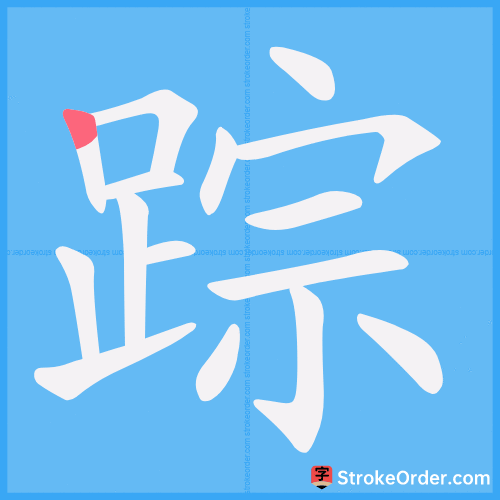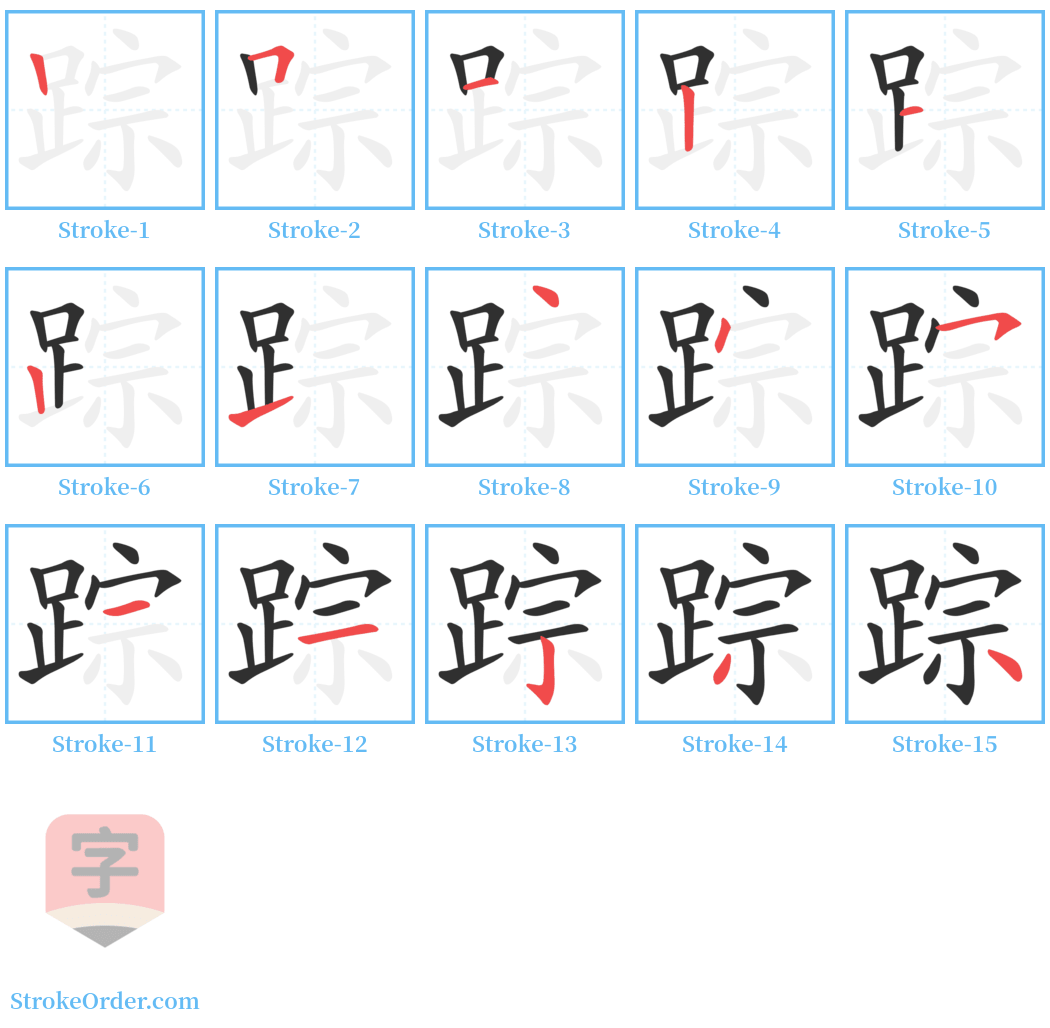踪 Stroke Order
Animated Stroke Order of 踪

Stroke Order Diagrams for 踪

Step-by-Step Handwriting Guide for 踪

Learn to Write Chinese Characters with Video Tutorials
Watch the video of writing the Chinese character "踪", learn the correct stroke order (笔顺) of the character "踪", and master the standard way of writing the character "踪".
Free Printable Handwriting Practice with Stroke Order: 踪
Printable Writing Practice Worksheet of "踪" in Portrait Orientation (Tian Zi Ge)

Printable Writing Practice Worksheet of "踪" in Landscape Orientation (Tian Zi Ge)

Information of 踪
Pinyin
zōng
Radical
足
Strokes
15 strokes
Usage
★★★★★
Definition
footprint / trace / tracks
踪 (zōng)
1. 人或动物走过留下的脚印。
[En.] The footprints left by a person or animal.
2. 人或动物走过留下的脚印:~影。~迹。追~。失~。跟~。无影无~。
[En.] Footprints left by a person or animal: shadow of a trace, trail, to pursue, lost track, to follow a trail, without a trace.
3. 事物的痕迹。
[En.] The trace of an object.
【本义】: 脚印,踪迹
[En.] The original meaning: footprints, traces.
【造字法】: 形声。从足,从(宗)声。
[En.] Character formation: phonetic compound; composed of the radical for 'foot' and the phonetic 'zong'.
同本义
1. 同本义 ([En.] trace)
[En.] Same original meaning.
事物的痕迹
2. 事物的痕迹 ([En.] track)
[En.] The mark of an object.
例句:
1. 李白《谒老君庙》:草合人踪断,尘浓鸟迹深。
[En.] Li Bai "Visiting the Laozi Temple": The grass closes in with no trace of people, dust thick, bird tracks deep.
2. 柳宗元《江雪》:千山鸟飞绝,万径人踪灭。
[En.] Liu Zongyuan "River Snow": Birds have flown away from a thousand mountains, all paths with no sign of people.
3. 宋· 苏轼《石钟山记》:访其遗踪。
[En.] Song, Su Shi "Record of Shizhong Mountain": To seek out its remains.
4. 《聊斋志异·促织》:绝无踪响。
[En.] "Strange Tales from a Chinese Studio": Absolutely without trace or sound.
5. 《广东军务记》:胆寒潜踪。
[En.] "Guangdong Military Affairs Record": Fearful of the hidden track.
又如:
- 蛰尘(尘世的事情)
- 蛰绪(踪迹,头绪)
- 蛰响(踪迹和声响)
- 蛰辙(踪迹)
[En.] Examples: track dust (worldly matters), track traces (hints), track sound (traces and sounds), track ruts (traces).
例句:
- 事情的始末; 跟踪
[En.] The beginning and end of a matter; follow the trail.
追随
[En.] To follow.
例句:
- 跟着走
[En.] To walk following someone.
引:
1. 《晋书·刘曜载书》:朕欲远追周文,近踪光武,使宗庙有太山之安。
[En.] "Book of Jin": I want to pursue Zhou Wen from afar, and closely follow Guangwu, so that the ancestral temple has the peace of Mount Tai.
2. 《隋书》:质菲薄而难踪,心恬愉而去惑。
[En.] "Book of Sui": They are of poor quality and difficult to trace, yet the mind is calm and rejoices, devoid of confusion.
又如:
踪行(跟着走)
[En.] Examples: to walk following someone.
Input Method for 踪
Pinyin
zong1
Wubi
khpi
Cangjie
rmjmf
Zhengma
jiwb
Four Corner
63191
Unicode
U+8e2a
Same Pronunciation Characters